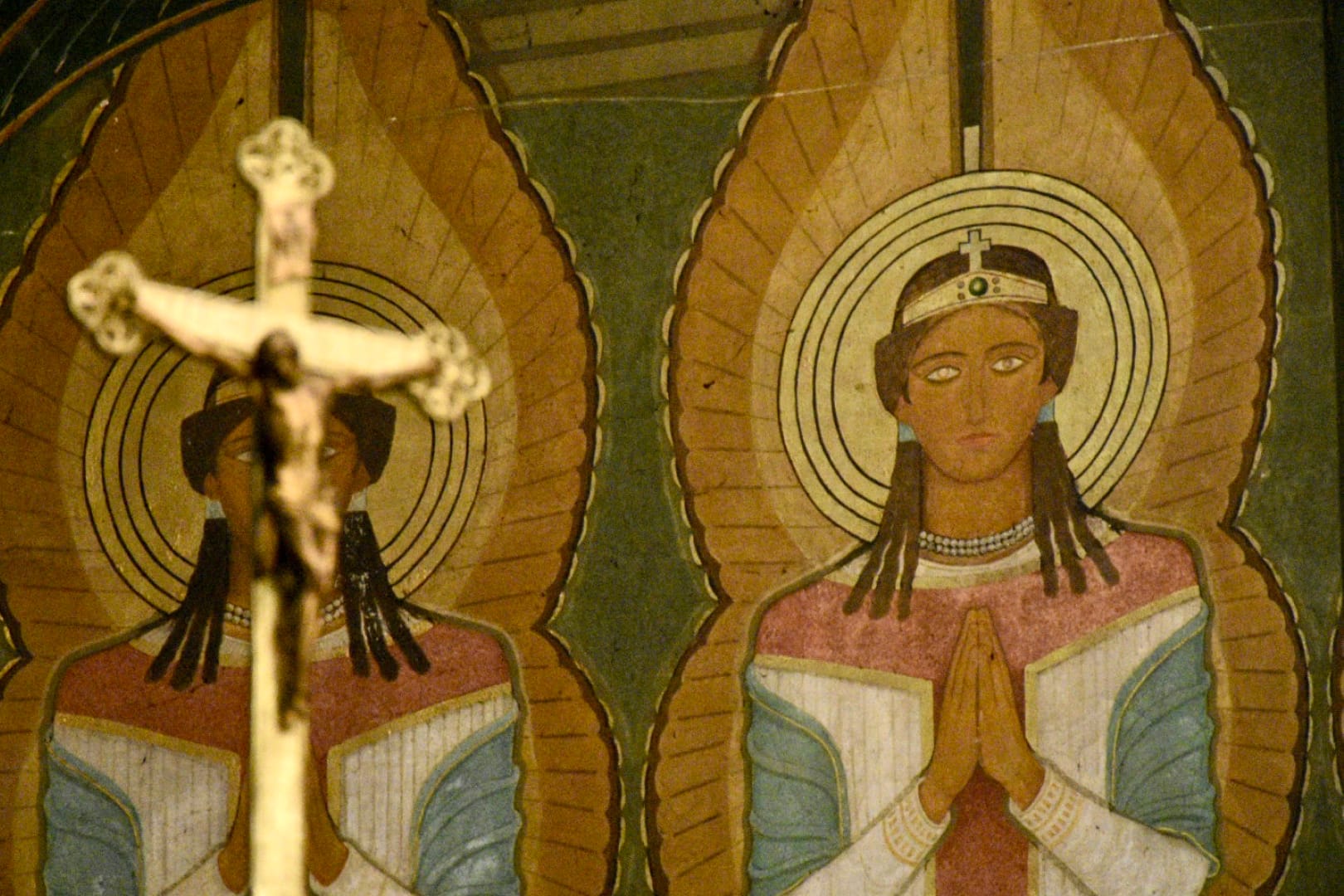What stories link to the past and present of a Neo-Romanesque building in Prague’s Smíchov? A lot of people associate the name “Gabriel Loci” with Designblok or the well-known glass-roofed Garden of Eden, that many filmmakers wanted to capture as part of their films. But the former monastery of Saint Gabriel, along with the Church of the Annunciation are much more than just movie props. Which is apparent from their many architectural and artistic treasures.
Beuron art – can you find it in Prague?
The main reason to visit the former monastery is simply the fact that it’s one of the most well preserved and also one of the most important examples of Beuron art in the world. This style, which is based on geometrical accuracy, muted colours and references of ancient art, is most associated with the Benedictine monk Peter Desiderius Lanz OSB, who became the leading name of Beuron Art School, founded in the year 1894. In the south-German Monastery of Saint Martin’s in Beuron is where boys and Benedictine monks have already been learning this style since the 70’s of the eighteenth century. The Iron Chancellor and architect of the German federacy Otto von Bismarck didn’t get along with the church, which caused the relocation of the Beuron monastery, first into Austria and then to Prague in 1880. Lenz and his co-worker P. Gabriel Wüger OSB first demonstrated their craft in the Czech lands with the decoration of the Imperial Chapel in Emmaus Monastery, where they worked as soon as in the year 1881, which is multiple years before the Beuron Art School was officially established. Lanz started working on his magnum opus – designs for the paint decoration of the church at Saint Gabriel’s – ten years later in the year 1891.
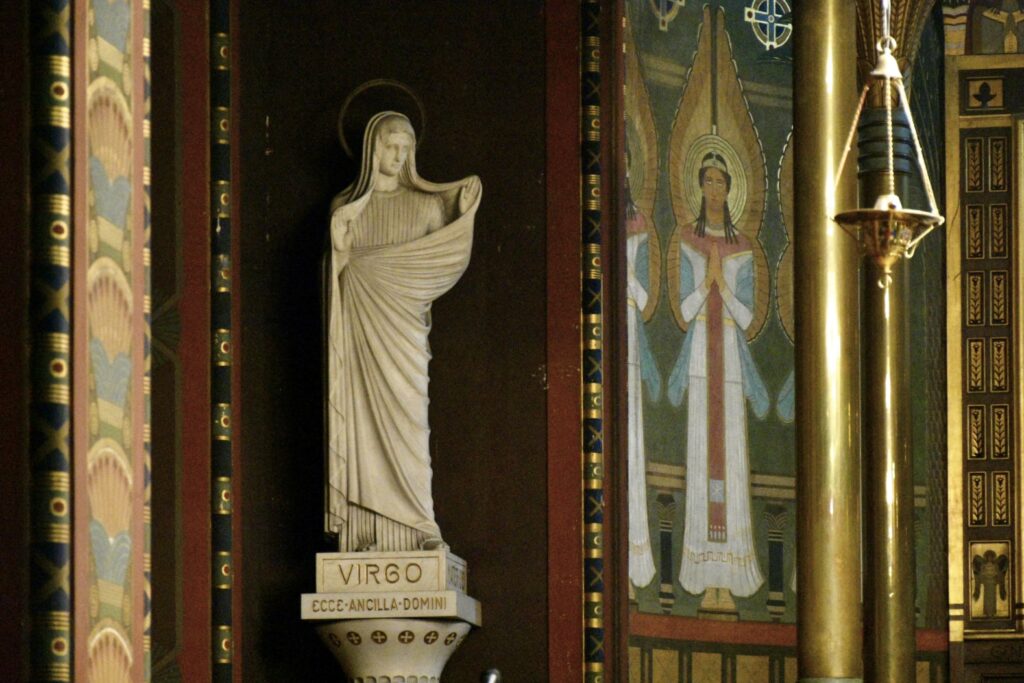
In Prague you can find religious cultural heritage sites along with paintings, statues and other artistic creations in the Beuron style in the interiors of Saint Gabriel Convent, in the Emmaus Monastery or in the Sacré Coeur Church in Holečkova street of Smíchov. A unique monument where Beuron art merges with secession style is hiding in the form of the Church of Saint Anna in Žižkov. Furthermore, we can travel to the Holy Family Church in Prague-Řepy or to the Church of the Virgin Mary of the Rosary in České Budějovice, but there is still more to discover.
Sister artists – is Beuron mural art a man’s domain?
Saint Gabriel’s Monastery was built between the years 1888–1891 in accordance with the designs made by Benedictine monks Hildebrand de Hemptinn and Ghislain Béthun, coming from the Beuron Maredsous Abbey in Belgium. The name of the vast grounds is borrowed from the duchess Gabriela von Sweerts-Sporck, or de facto from the patron of her name: Saint archangel Gabriel. The generous donor duchess unfortunately didn’t live long enough to see the final form of the convent and church, but her financial support made it possible to create a truly unique space. It boasts not only a special approach to the synthesis of different art styles (so called Gesamtkunstwerk), but also a truly unique working regimen. That’s because P. Desiderius Lenz also taught the art of painting to the Benedictine sisters, who by 1899 moved from Saltzburg’s Nonnberg Abbey into the newly built convent of Saint Gabriel.
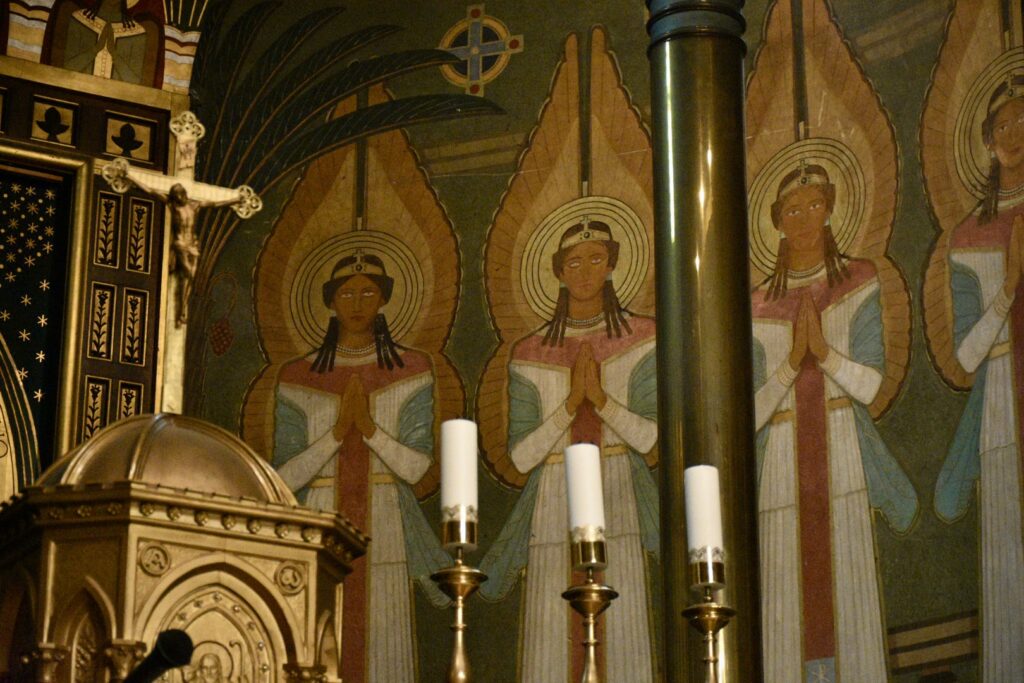
At the turn of the 19. and 20. century it wasn’t customary that women would be allowed to carry out such an important task, as is religious murals. Even the church of Saint Gabriel is enriched by a unique painting of angels inside the apse, which is a piece made by the female inhabitants of the convent: the Benedictine sisters. The sisters also painted the Saint Gabriel Evangeliary (a book containing excerpts from gospels), rituals, illustrations for Liturgies of the Hours and others, which they published themselves.
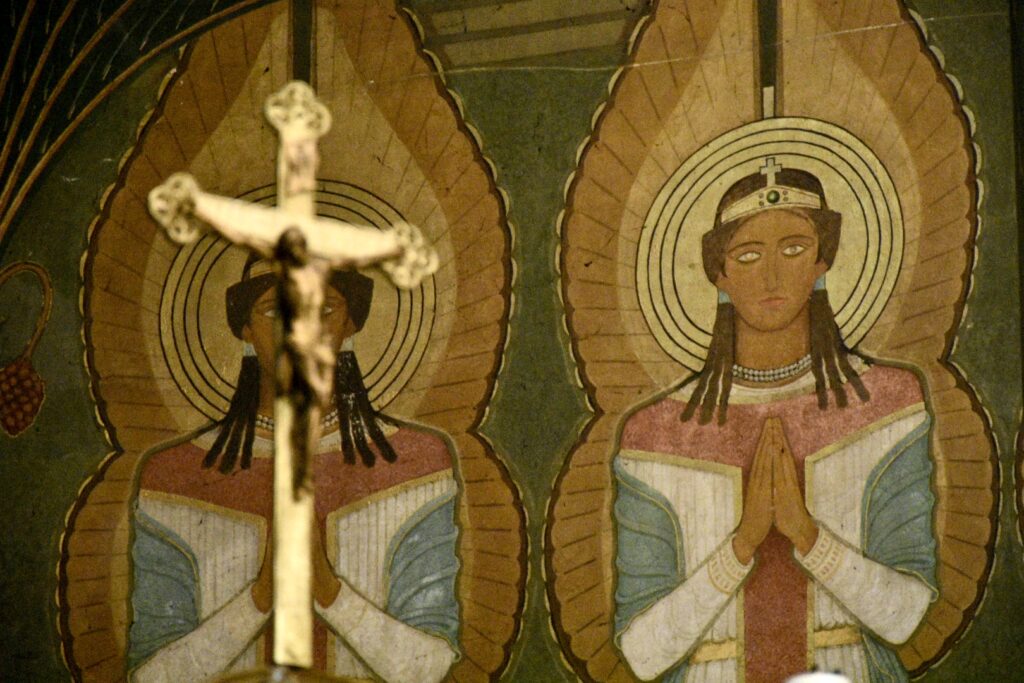
The interior of the church is rich with unconventional colours. Depictions of individual saints look more like murals from late Middle Ages influenced by Egypt, rather than the beginning of the 20. century.
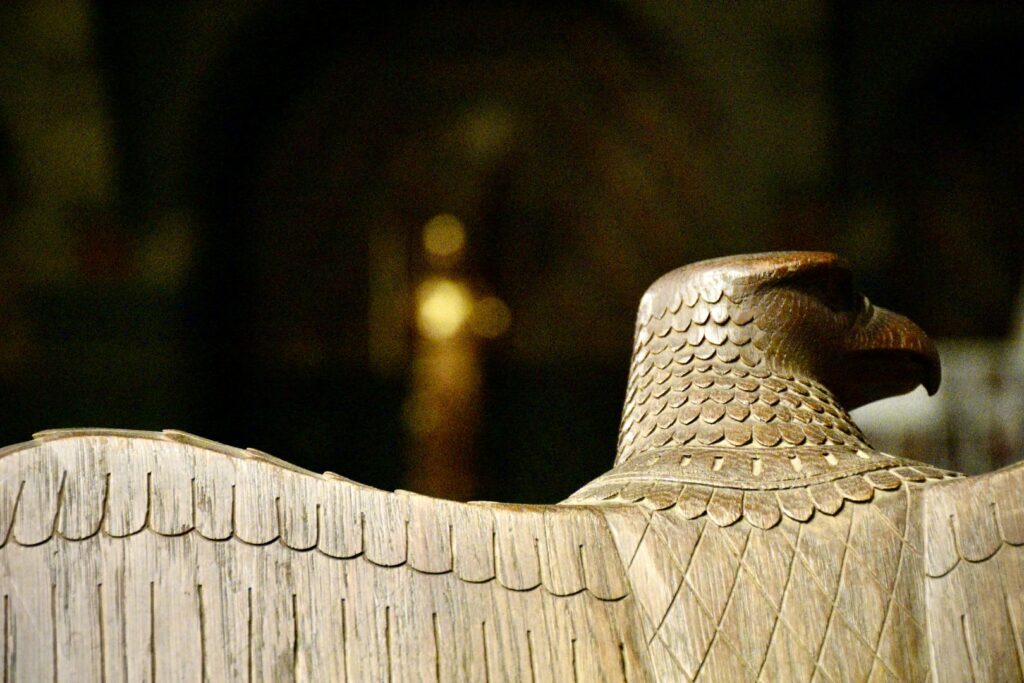
Beuron art drew inspiration from ancient Egypt, which is apparent in the mutual resemblance of the way figures are depicted, including the colour palette. A particular example is a reading stand depicting a falcon located in the chancel of the church. Falcon is associated with the Egyptian god of skies Horus.
Beuron art didn’t only find inspiration in the past. An important part of it was searching for the ideal path leading to God. Lenz himself was convinced that the path to perfection is made of mathematics and geometry that define precision and order. Murals as we know them from baroque churches have been substituted by precisely calculated shapes and geometric motifs. Beuron artists, monks, oblates and religious sisters worked in unity, not as individuals creating with their individual desires in mind. Every draft that aesthetically harmonised with the decorations as a whole, could make it onto the walls of the church if it got approved by the main author of the whole concept D. P. Lanz. Lanz was also an authority for the Benedictine sisters, who he had been teaching for a whole six years. If he didn’t like something about a particular painting or décor, he made his opinion clear, and the offensive piece was in many cases tweaked or even exchanged completely.
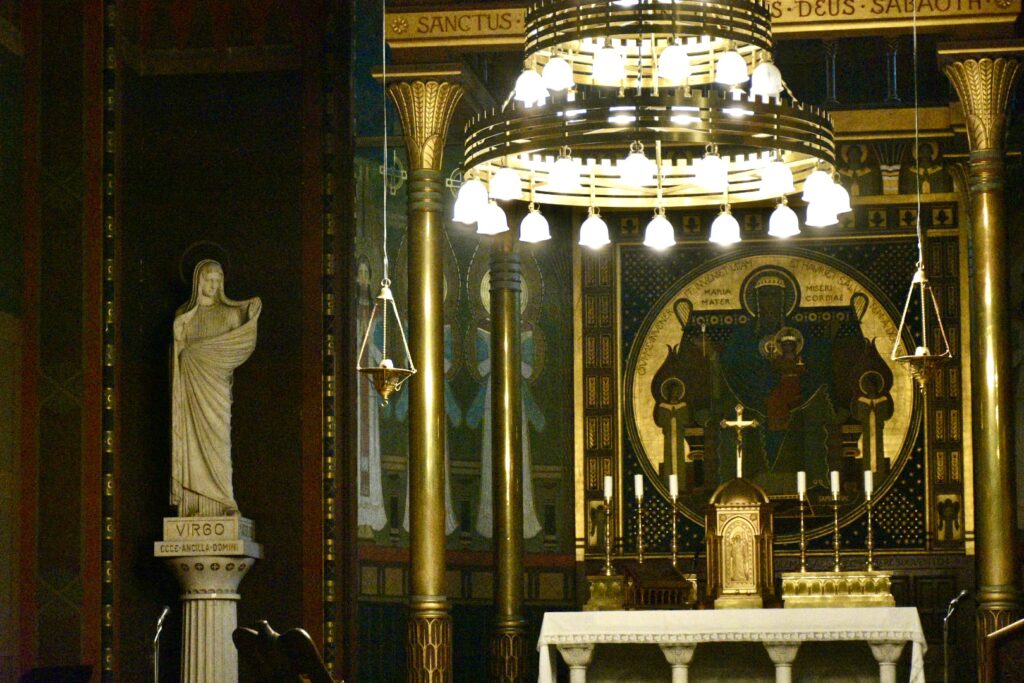
The term gesamtkunstwerk is of German origin and essentially means “total work of art”. In architecture the term refers to an overall building concept, where every individuality is designed for a specific place. It is the very interior decoration of the convent, born under the watchful eye of D. P. Lenz, that serves as an example of this approach to architecture.
From Prague to Styria – where did the décor and furniture go?
During the formation of the new Czechoslovak Republic the sisters decided to sell both the church and the convent, due to the fear of them being confiscated. That decision ended up in the move of approximately a hundred Benedictine sisters from Prague Smíchov to the Bertholdstein castle in Austrian Styria. And the sisters ended up bringing a lot of what they created in Smíchov – chandeliers, metal bars, carpets and others all disappeared from the church. All that stayed was the murals, built-in bookshelves, benches and a metal grid that separates the chancel from the nave of the church. Part of the church and convent movables has since returned to Prague, thanks to the efforts of the Society of Friends of Beuron Arts and the Malakim Foundation. The most recently returned “addition” is a ceremonial carpet, also known as Elephant or Egyptian, which arrived back in Prague in 2023 and was designed by the sisters from painting and embroidery workshops. The carpet was placed in the chancel of the church during special occasions, and is full of colour and various motives, just like all the other décor. What makes it the most striking though, is the repeated symbolic pattern of moon, sun, elephants, fish and birds, which is quite uncommon for the Czech environment.
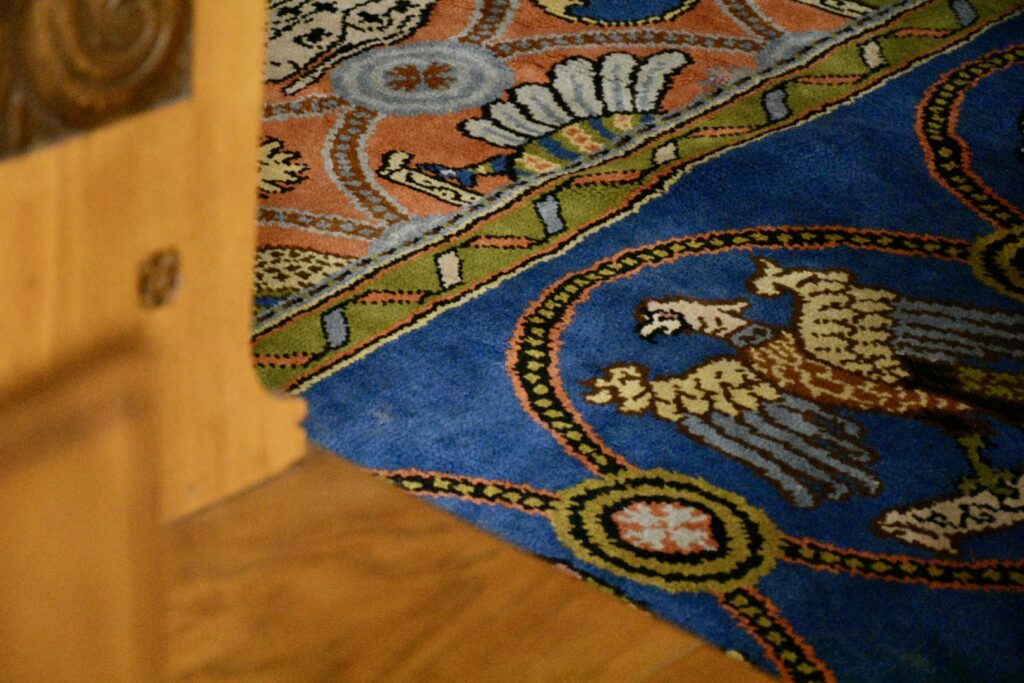
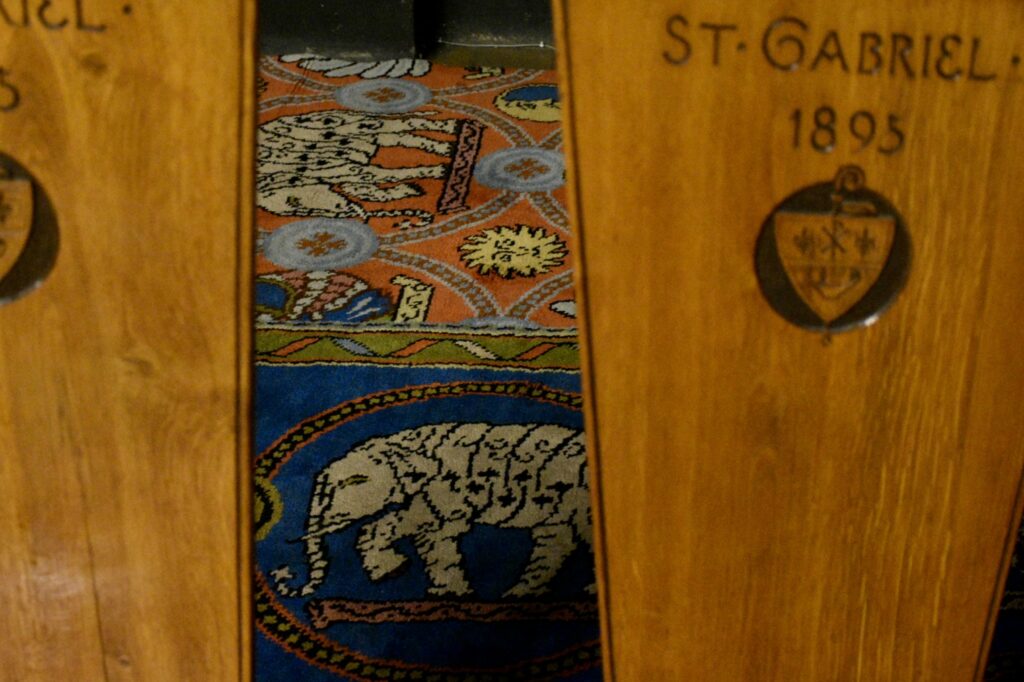
The carpet spent more than one hundred years in Austrian Styria. Either way, his current form is only a part of its impressive entirety, which was divided into multiple smaller pieces. This handwoven art piece is yet another part of the puzzle, that is the whole harmony of the church interior.
Various functions – a nunnery, the Ministry of Telegraphs, the Czech Post Office or a luxury hotel?
The sisters spent a mere 30 years in the Neo-Romanesque building – since they came from Saltzburg in 1899, until 1918/19 when they left the territory of a forming young republic. The whole complex was bought by the Ministry of Post and Telegraphs in 1919, which ended up radically changing multiple aspects of the convent. Most famously they ended up building a colourful glass roof over the Garden of Eden, similar to the design of the hall of the Czech post branch in Jindřišská street. It is this ministry that is linked to the longest episode in history of the Smíchov complex. Aside from a post office, headquarters and a directory, there was also the Museum of Post, which later moved to Vávra’s mill between 1986–1988. All that was left in the convent, in the convent library to be exact, was the archives that ended their operation here in 2016. The complex has been in the hands of a private investor since 2020. Thanks to that many artists and craftsmen have been able to rent out a spot in the former convent. But unfortunately, since the whole building complex is in need of extensive repairs, the investor made the choice to use it in favour of tourists in the future. The former convent will once again be used as accommodation, this time as a five-star hotel.
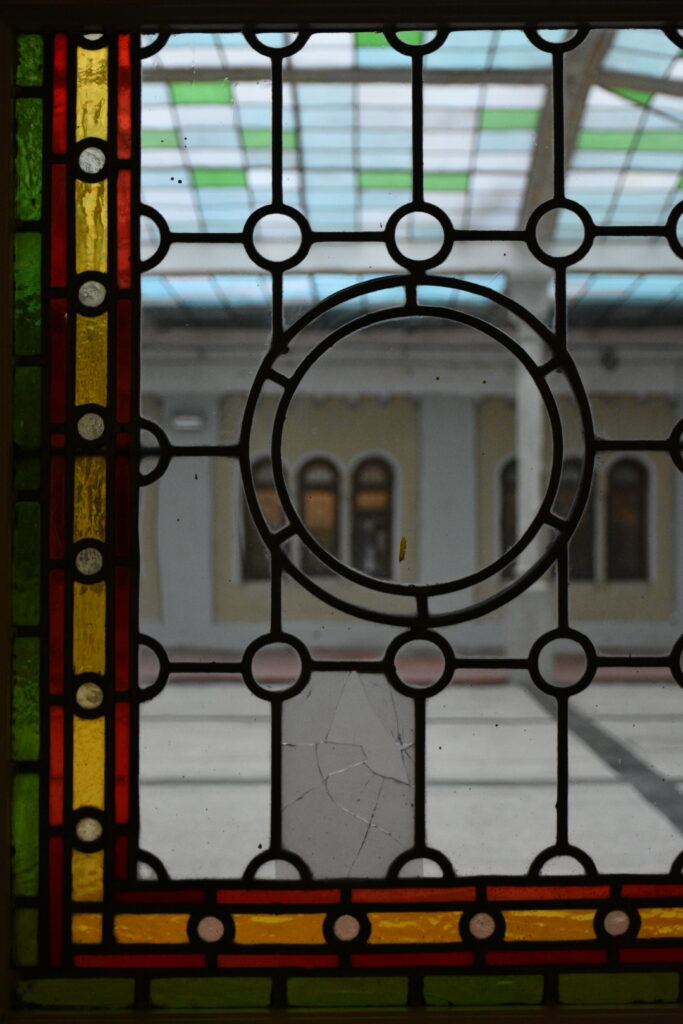
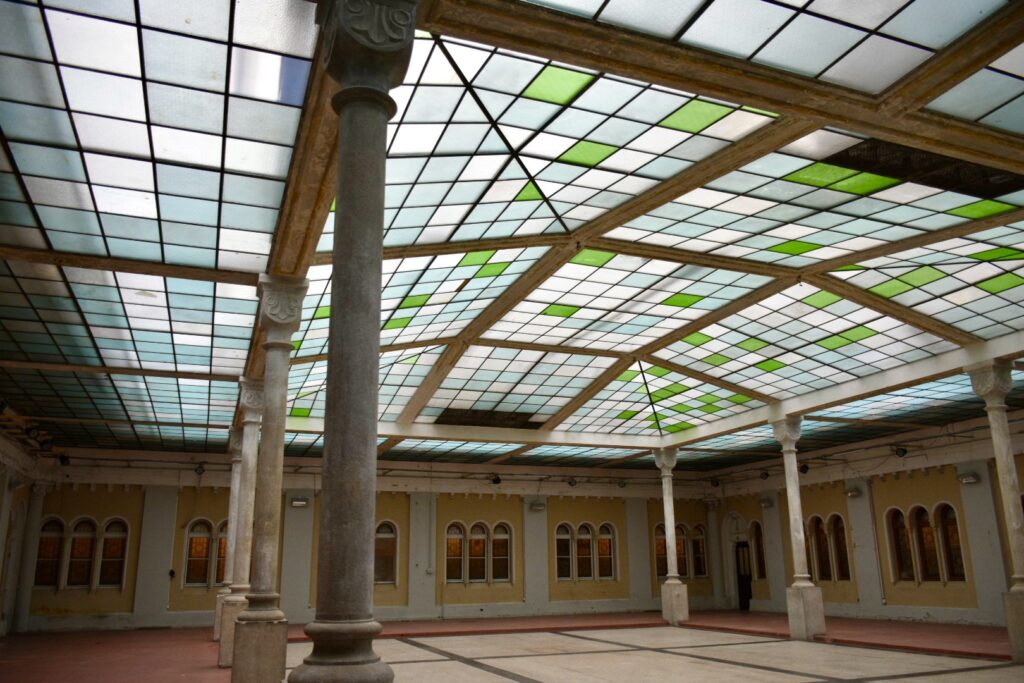
The roofed Garden of Eden has been a favourite spot for organising events (Designblok included) and shooting movie scenes since 2020. It has been used for the Academy winning film All Quiet on the Western Front, a Netflix-produced blockbuster Extraction 2 or a Czech series First Republic and Specialists.
Restoration probes – how conservator and Benedictine sister Petra discovered Moses
In 1919, after the Ministry of posts and telegraphs moved in, most of the convent walls were overpainted white. Figures of saints painted on the walls, in many cases by the Benedictine sisters themselves, have been disrespectfully hidden in the pursuit of making the whole interior more official. At the moment the owner CIMEX GROUP is funding conservation research in the form of 750 small restoration probes that gradually reveal what hides under the layers of overpaint. This way the government protected cultural heritage shouldn’t encounter adverse phenomena like the disruption of character, loss of historical value or its genius loci. At least that’s how it seems from the aforementioned conservation research, that reveals everything that has been hidden for tens of years. One of the members of the conservation team Sister Petra Pavlíčková OSB even found an original depiction of Moses.
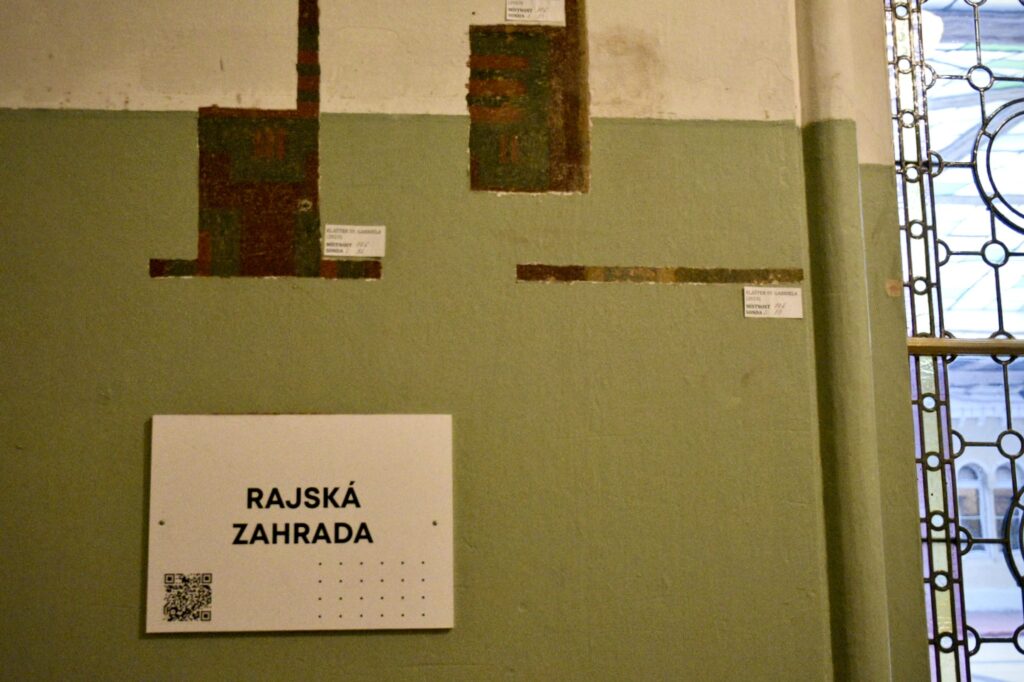
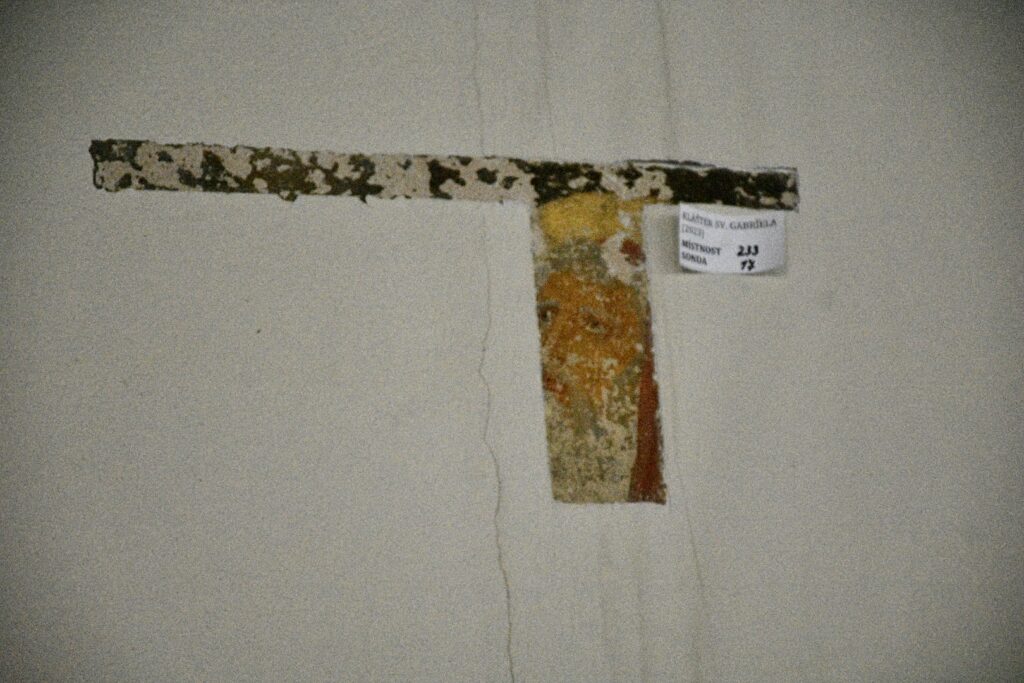
Some walls, such as in the cloister, have been layered with up to 8 different overpaints. Here’s to hoping that the recovery will continue and that there will be more murals uncovered in the future, after being in the dark for more than one hundred years.
Czech modernity – did Beuron artists contribute to its inception?
The philosophy of Beuron art was to return to ancient art, to the feel of precision and geometry, which could have been inspirational to the upcoming architects – namely Jan Kotěra, Josip Plečnik or famous artist František Bílek. His own villa, designed by Bílek and located at Prague’s Hradčany, is captivating not only for the artist’s signature style, but also for the terrace columns mimicking the style of Egyptian wheat stalks. You can see the reference to ancient Egyptian architecture, just like in Beuron art. There is a sense of incredible timelessness in the Church of the Annunciation. The Benedictine sisters led by P. Desiderius Lenz has managed to create incredible treasures with aspects of modernism before many of the architectural world first came up with principles of modernity.
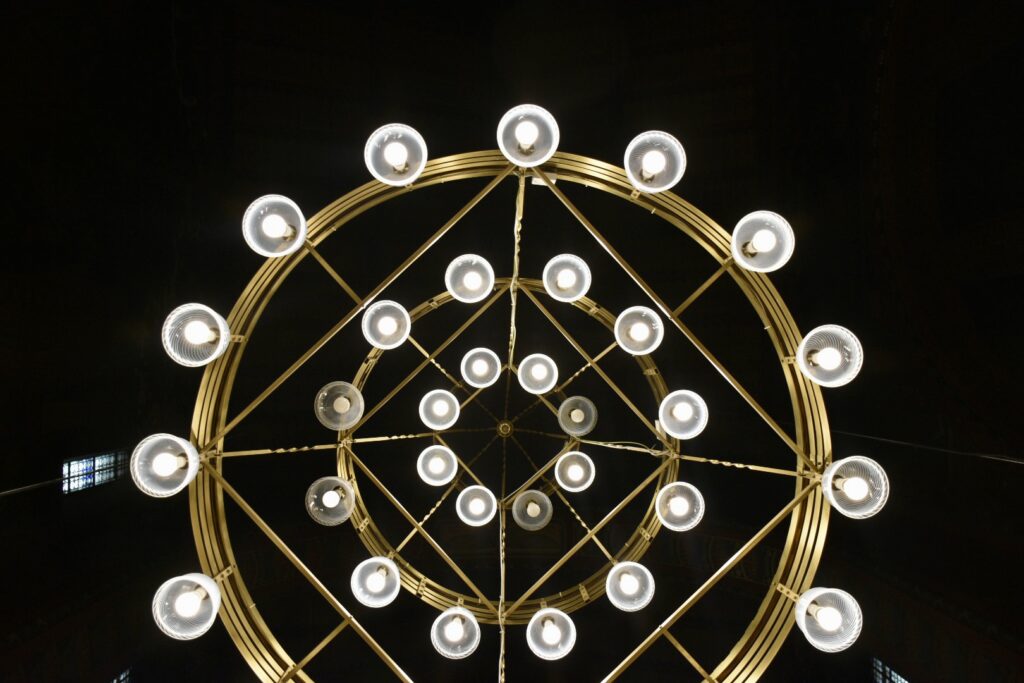
There were two identical chandeliers hanging in the chancel and choir between the years 1911–1913. They are similar in certain aspects to designs of movements like geometric secession and Czech modernity. Visiting the former convent is unforgettable. It brings you closer to the forgotten Beuron art and it can inspire you, just as it inspired many famous artists and architects.
In the name of Mapamátky we would like to warmly thank Ms Monika Bubna-Litic, for showing us around the interiors of the convent and church. If you get the opportunity to join her for a tour, don’t waste any time! You will get to imagine what the life of Benedictine sisters was like at Prague’s Smíchov and you will get to hear stories of the buildings from someone, who seems to know all there is to know about the magical place.
